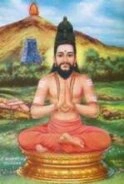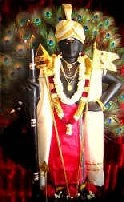

திரு அருணகிரிநாதர் அருளிய
திருப்புகழ்
Sri AruNagirinAthar's
Thiruppugazh

 |  திரு அருணகிரிநாதர் அருளிய Sri AruNagirinAthar's |  |
|---|
| (இந்த வலைத்தளத்தைப் பயன்படுத்துவதற்கு முன்பு எனது முக்கியக் குறிப்பைப் படியுங்கள் - நன்றி). (Please read my important note before using this website - Thank You). |
| திருப்புகழ் 498 கோதிக் கோதி (சிதம்பரம்) Thiruppugazh 498 kOdhikkOdhi (chidhambaram) |
 |  | தமிழிலும் ஆங்கிலத்திலும் பொருள் எழுதியது ஸ்ரீ கோபால சுந்தரம் Meanings in Tamil and English by Sri Gopala Sundaram | English PDF அமைப்பு in PDF | ஆலய வரிசை அகரவரிசை எண்வரிசை தேடல் venue list alphabetical numerical search |
|
தானத் தானத் தாந்தன தானன தானத் தானத் தாந்தன தானன தானத் தானத் தாந்தன தானன ...... தனதான ......... பாடல் ......... கோதிக் கோதிக் கூந்தலி லேமலர் பாவித் தாகச் சாந்தணி வார்முலை கோடுத் தானைத் தேன்துவர் வாய்மொழி ...... குயில்போலக் கூவிக் கூவிக் காண்டிசை போலவெ நாணிக் கூனிப் பாய்ந்திடு வார்சிலர் கூடித் தேறிச் சூழ்ந்திடு வார்பொருள் ...... வருமோவென் றோதித் தோளிற் பூந்துகி லால்முலை மூடிச் சூதிற் றூங்கமி லார்தெரு வோடித் தேடிச் சோம்பிடு வார்சில ...... விலைமாதர் ஓருச் சேரச் சேர்ந்திடு வார்கலி சூளைக் காரச் சாங்கமி லார்சில வோரைச் சாகத் தீம்பிடு வார்செய ...... லுறவாமோ வேதத் தோனைக் காந்தள்கை யால்தலை மேல்குட் டாடிப் பாந்தள் சதாமுடி வீரிட் டாடக் காய்ந்தசு ரார்கள்மெல் ...... விடும்வேலா வேளைச் சீறித் தூங்கலொ டேவய மாவைத் தோலைச் சேர்ந்தணி வாரிட மீதுற் றாள்பொற் சாம்பவி மாதுமை ...... தருசேயே நாதத் தோசைக் காண்டுணை யேசுடர் மூலத் தோனைத் தூண்டிட வேயுயிர் நாடிக் காலிற் சேர்ந்திட வேயருள் ...... சுரமானை ஞானப் பால்முத் தேன்சுரு பாள்வளி மாதைக் கானிற் சேர்ந்தணை வாய்சிவ ஞானப் பூமித் தேன்புலி யூர்மகிழ் ...... பெருமாளே. ......... சொல் விளக்கம் ......... கோதிக் கோதிக் கூந்தலிலே மலர் பாவித்து ஆக(ம்) சாந்து அணிவார் முலை கோடுத் தானை ... ஆய்ந்து ஆய்ந்து கூந்தலில் மலர்களைப் பரப்பிச் சூட்டி, உடலில் சந்தனம் அணிந்துள்ள மார்பு என்னும் மலை போன்ற சேனையுடன், தேன் துவர் வாய் மொழி குயில் போலக் கூவிக் கூவிக் காண்டு இசை போலவெ நாணி கூனி பாய்ந்திடுவார் சிலர் ... பவளம் போன்ற வாயால் தேன் போன்ற மொழியால் குயில் போலக் கூவி அழைத்து, (ஆடவர்களைக்) கண்டு இசையுடன், பேசும் பேச்சுக்குத் தக்கபடி வெட்கப்பட்டும், (ஒரு சமயம்) குனிந்தும், (மற்றொரு சமயம்) பாய்ந்தும் சில பொது மகளிர் நடிப்பர். கூடித் தேறிச் சூழ்ந்திடுவார் பொருள் வருமோ என்று ஓதித் தோளில் பூந்துகிலால் முலை மூடிச் சூதில் தூங்கம் இலார் தெரு ஓடித் தேடிச் சோம்பிடுவார் சில விலைமாதர் ... ஒன்று கூடியும், தெளிவுற்றும் சூழ்ந்து யோசிப்பவர்களாய், பொருள் கிடைக்குமோ என்று பேசி, தோள் மீதுள்ள அழகிய புடவையால் மார்பை மூடி, வஞ்சனை எண்ணத்துடன் தூக்கம் இல்லாத கண்களுடன் தெருவில் ஓடியும் (வாடிக்கையாளரைத்) தேடியும், சில வேசிகள் சோம்பலாய்க் காலம் கழிப்பர். ஓருச் சேரச் சேர்ந்திடுவார் கலி சூளைக்காரச் சாங்கமிலார் சிலவோரைச் சாகத் தீம்பிடுவார் செயல் உறவாமோ ... ஒருமிக்க தரித்திர நிலையைச் சேர்ந்தவர்களாய், வேசிகளாய், நல் ஒழுக்கம் இல்லாதவர்களாய், (தம்மிடம் வரும்) சிலரைச் சாகும் அளவுக்கு கேடு செய்பவர்களாகிய விலைமாதர்களின் தொழில்களில் உறவு கொள்ளுதல் நல்லதா? வேதத்தோனைக் காந்தள் கையால் தலை மேல் குட்டு ஆடிப் பாந்தள் சதா முடி வீரிட்டு ஆடக் காய்ந்து அசுரார்கள் மெல் விடும் வேலா ... வேதம் வல்ல பிரமனை காந்தள் மலர் போன்ற கையால் தலையில் குட்டி விளையாடி, ஆதிசேஷனாகிய பாம்பின் நூற்றுக் கணக்கான முடிகள் வேதனைப்பட்டு அசையக் கோபித்து, அசுரர்களின் மேல் வேலாயுதத்தைச் செலுத்தியவனே, வேளைச் சீறித் தூங்கலொடே வயமாவைத் தோலைச் சேர்ந்து அணிவார் இட மீது உற்றாள் பொன் சாம்பவி மாது உமை தரு சேயே ... மன்மதனைக் கோபித்து, யானையுடன் புலியின் தோலைப் போர்வையாகவும், உடையாகவும் ஒரு சேர அணிந்தவராகிய சிவபெருமானுடைய இடப்பாகத்தில் உறையும் அழகிய சாம்பவியாகிய மாதா, உமை பெற்ற குழந்தையே, நாதத்து ஓசைக் காண் துணையே சுடர் மூலத்தோனைத் தூண்டிடவே உயிர் நாடிக் காலில் சேர்ந்திடவே அருள் ... உனது திருச்சிலம்போசை முதலிய நாதங்களைக் கேட்பதற்குத் துணை புரியும் தேவனே, மூலாதாரக் கனலைத் தூண்டி எழுப்பி, பிராணவாயு சுழுமுனை* நாடி மார்க்கத்தில் சார்வதற்கு அருள் புரிவாயாக. சுர மானைஞானப் பால் முத்தேன் சுருபாள் வ(ள்)ளி மாதைக் கானில் சேர்ந்து அணைவாய் ... தேவ லோகத்தில் வளர்ந்த மான் போன்ற தேவயானையையும், ஞானப் பால் போலவும் முப்பழங்களின் தேன் போலவும் இனிய சொரூபத்தை உடையவளும் ஆகிய வள்ளி நாயகியை தினைப் புனக் காட்டிலும் சேர்ந்து தழுவியவனே, சிவ ஞானப் பூமி தேன் புலியூர் மகிழ் பெருமாளே. ... சிவஞானப் பூமியாகிய அழகிய புலியூரில் (சிதம்பரத்தில்) மகிழ்ந்து விளங்கும் பெருமாளே. |
* இங்கு சிவயோக முறைகள் விளக்கப்பட்டுள்ளன. அதன் சுருக்கம் வருமாறு: நாம் உள்ளுக்கு இழுக்கும் காற்றுக்குப் 'பூரகம்' என்றும், வெளிவிடும் காற்றுக்கு 'ரேசகம்' என்றும் பெயர். உள்ளே நிறுத்திவைக்கப்படும் காற்றுக்கு 'கும்பகம்' என்று பெயர். உட் கொள்ளும் பிராணவாயு உடலில் குறிப்பிட்ட 'ஆதாரங்கள்' (நிலைகள், சக்கரங்கள்) மூலமாகப் படிப்படியாகப் பரவி, மேல் நோக்கிச் சென்று, தலையில் 'பிரம கபால'த்தில் உள்ள 'ஸஹஸ்ராரம்' (பிந்து சக்கரம்) என்ற சக்கரத்துக்குச் செல்லும். இந்த ஐக்கியம் ஏற்படும்போது, அமுத சக்தி பிறந்து, ஆறு ஆதாரங்களுக்கும் ஊட்டப்பட்டு, மீண்டும் அதே வழியில் 'மூலாதார'த்தை வந்து அடையும். இந்த ஆதாரங்களை ஒழுங்கு படுத்தும் வகையில் மூன்று 'மண்டல'ங்களும் (அக்கினி, ஆதித்த, சந்திர மண்டலங்கள்), பத்து 'நாடி'களும் (இடைகலை, பிங்கலை, சுழுமுனை முதலியன) உள்ளன. 'இடைகலை' பத்து நாடிகளுள் ஒன்று. இடது நாசியால் விடும் சுவாசம். 'பிங்கலை' பத்து நாடிகளுள் ஒன்று. வலது நாசி வழியால் விடும் சுவாசம். 'சுழு முனை' இடைகலைக்கும் பிங்கலைக்கும் இடையில் உள்ளது. 'சுழு முனை' ஆதாரம் ஆறிலும் ஊடுருவி நிற்பது. 'இடைகலை'யும், 'பிங்கலை'யும் ஒன்றுக்கொன்று பின்னி நிற்பன. சுவாச நடப்பை 'ப்ராணாயாமம்' என்ற யோக வன்மையால் கட்டுப்படுத்தினால் மன அமைதி ஏற்படும். |
| 'wikisource' reference links for this song இப்பாடலுக்கான 'விக்கிமூலம்' இணையப் பக்கங்கள் pg 2.495 pg 2.496 pg 2.497 pg 2.498 WIKI_urai Song number: 639 goto wiki alpha list (Please note: Kaumaram.com is NOT responsible for accuracy and contents of external links) |
| மன்னிக்கவும், இப்பாடலுக்கு ஒலிப்பதிவுகள் இல்லை Sorry, no audio recordings for this song |
(Please note: Kaumaram.com is NOT responsible for accuracy and contents of external links) top |
|
Song 498 - kOdhik kOdhi (chidhambaram) kOthik kOthik kUnthali lEmalar pAvith thAkac chAnthaNi vArmulai kOduth thAnaith thEnthuvar vAymozhi ...... kuyilpOlak kUvik kUvik kANdisai pOlave nANik kUnip pAynthidu vArsilar kUdith thERic cUzhnthidu vArporuL ...... varumOven ROthith thOLiR pUnthuki lAlmulai mUdic cUthit RUngami lArtheru vOdith thEdic chOmpidu vArsila ...... vilaimAthar Oruc chErac chErnthidu vArkali cULaik kArac chAngami lArsila vOraic chAkath theempidu vArseya ...... luRavAmO vEthath thOnaik kAnthaLkai yAlthalai mElkut tAdip pAnthaLsa thAmudi veerit tAdak kAynthasu rArkaLmel ...... vidumvElA vELaic cheeRith thUngalo dEvaya mAvaith thOlaic chErnthaNi vArida meethut RALpoR chAmpavi mAthumai ...... tharusEyE nAthath thOsaik kANduNai yEsudar mUlath thOnaith thUNdida vEyuyir nAdik kAliR chErnthida vEyaruL ...... suramAnai njAnap pAlmuth thEnsuru pALvaLi mAthaik kAniR chErnthaNai vAysiva njAnap pUmith thEnpuli yUrmakizh ...... perumALE. ......... Meaning ......... kOthik kOthik kUnthalilE malar pAviththu Aka(m) sAnthu aNivAr mulai kOduth thAnai: After carefully combing the hair and wearing an assortment of flowers spread out on the tuft, these women smear the sandalwood paste on their body equipped with the army of mountain-like breasts; thEn thuvar vAy mozhi kuyil pOlak kUvik kUvik kANdu isai pOlave nANi kUni pAynthiduvAr silar: a few whores keep on cooing like the cuckoo and speak honey-like words emanating from their coral-like mouth, inviting young men musically; when they see their suitors, they display feigned modesty; according to the men's speech, they stoop down at times and fiercely attack the men some other time; kUdith thERic cUzhnthiduvAr poruL varumO enRu Othith thOLil pUnthukilAl mulai mUdic cUthil thUngam ilAr theru Odith thEdic chOmpiduvAr sila vilai mAthar: some other whores get together among themselves in a circle, pretending to contemplate matters clearly; they loudly wonder how they would be able to grab money (from their suitors); they cover their bosom with the free end of the pretty sari lying on their shoulder, run around in the street and look for potential victims with sleepless eyes and treacherous thoughts and while away their time lazily; Oruc chErac chErnthiduvAr kali cULaikkArac chAngamilAr silavOraic chAkath theempiduvAr seyal uRavAmO: These whores are altogether poverty-stricken, lacking any virtue whatsoever, and are capable of causing misery to some of their suitors to the point of driving them to death; will there be any good coming out of the liaison with such evil-minded whores? vEthaththOnaik kAnthaL kaiyAl thalai mEl kuttu Adip pAnthaL sathA mudi veerittu Adak kAynthu asurArkaL mel vidum vElA: Hitting playfully with Your daffodil-like knuckles on the head of Brahma, who is well-versed in the VEdAs, and fiercely raging over the Serpent AdhisEshan making its hundreds of hoods shake in pain, You wielded the spear on the demons, Oh Lord! vELaic cheeRith thUngalodE vayamAvaith thOlaic chErnthu aNivAr ida meethu uRRAL pon sAmpavi mAthu umai tharu sEyE: He gave vent to His anger on Manmathan (God of Love) and wore simultaneously the hides of the elephant and the tiger, respectively, as a shawl and loin-cloth; on the left side of that Lord SivA's body is concorporate the beautiful Mother SAmbhavi; and You are the child delivered by that Goddess UmA! nAthaththu Osaik kAN thuNaiyE sudar mUlaththOnaith thUNdidavE uyir nAdik kAlil sErnthidavE aruL: You are the Deity that comes to my aid for listening to the melodious sounds like the jingling of Your hallowed anklets! By arousing the basic chakra (Primary Flame) within me, kindly bless me so that the air of life (oxygen) climbs along the path of Susumna*, Oh Lord! sura mAnainjAnap pAl muththEn surupAL va(L)Li mAthaik kAnil sErnthu aNaivAy: DEvayAnai, the deer-like damsel who was reared in the celestial land, along with VaLLi, whose figure is sweet like the milk of true knowledge and the juice squeezed from the three great fruits (mango, plantain and jack fruit), were simultaneously hugged by You in the millet-field of the forest, Oh Lord! siva njAnap pUmi thEn puliyUr makizh perumALE.: This beautiful place PuliyUr (Chidhambaram) is the centre of True Knowledge of Siva, and You are seated here with relish, Oh Great One! |
* In this song, several Siva-yOgA principles are explained: The inhaled air is known as 'pUragam' and the exhaled air is 'rechagam'. The retained air is 'kumbagam'. The oxygen that enters the body climbs up step by step through several centres, known as 'chakrAs' and ultimately reaches 'sahasrAram' or 'bindhuchakram' on the top of the skull. At that point of union, nectar flows from that chakrA and seeps through and soaks the six centres of the body and returns to the basic chakrA, 'mUlAthAram'. Three zones (namely, the sun zone, the moon zone and the fire zone) and ten nerves ('nAdis') govern the six centres; the principal nerves are 'susumna', 'idaikala' and 'pingala'. idakala: one of the ten 'nAdis' (nerves), when inhalation takes place through the left nostril; pingala: one of the ten 'nAdis' (nerves), when inhalation takes place through the right nostril; susumna: one of the ten 'nAdis' (nerves), situated between the above two 'nadis', and running through the spinal chord covering all the six centres of 'kundalini'. ('idakala' and 'pingala' are entwined around 'susumna'). If breathing is controlled through a yOgA called 'praNAyAmA', the mind becomes tranquil. |
| தமிழில் PDF அமைப்பு ஆலய வரிசை அகரவரிசை எண்வரிசை |
| ... https://kaumaram.com ... The website for Lord Murugan and His Devotees முகப்பு அட்டவணை மேலே home contents top |
Kaumaram.com is a non-commercial website. This website is a dedication of Love for Lord Murugan. PLEASE do not ask me for songs about other deities or for BOOKS - This is NOT a bookshop - sorry. Please take note that Kaumaram.com DOES NOT solicit any funding, DIRECTLY or INDIRECTLY. © Copyright Kaumaram dot com - 2001-2040 COMMERCIAL USE OF MATERIAL IN THIS WEBSITE IS NOT PERMITTED. Please contact me (the webmaster), if you wish to place a link in your website. email: kaumaram@gmail.com Disclaimer: Although necessary efforts have been taken by me (the webmaster), to keep the items in https://kaumaram.com safe from viruses etc., I am NOT responsible for any damage caused by use of and/or downloading of any item from this website or from linked external sites. Please use updated ANTI-VIRUS program to rescan all downloaded items from the internet for maximum safety and security. மேலே top |